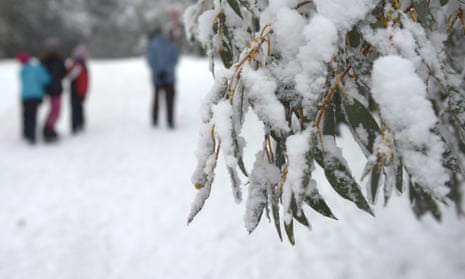Sydney, Melbourne and Hobart will kiss goodbye to the sunshine this weekend when a “polar blast” of icy air will send temperatures plummeting on Sunday, bringing rain, snow and even hail in some regions.
Jonathan How, a meteorologist at the Bureau of Meteorology, said a cold front expected for Friday would be followed by a second front on Saturday, created by a “polar blast” moving north from the Antarctic.
Together they will deliver what may the coldest day of the year so far.
“This is looking to be the last hurrah of the warm season and the summer,” How said. “The first cold front is a garden-variety cold front. The next one is the leading edge of this air mass moving north from the Southern Ocean. It’s a low pressure system that has been circulating the Antarctic.
“Sometimes we see the these systems jump up towards Australia and that’s when we see these winter blasts.
“This will be the last time we see the high 20s and low 30s until next spring.”
On Sunday the conditions will move through to Sydney, making for a chilly weekend.
“Even though we’re not going to see any record broken, the main message is that it is going to be quite uncomfortably chilly,” How said. “This sudden swing will catch people by surprise.”
On current BoM projections, the weather in Sydney will hit a low of 13C on Sunday, with the mercury falling to 10C in Melbourne and 0C in Canberra on Monday.
The cold temperatures are expected to bring the first snowfalls of the season across the eastern seaboard, with a dusting at 700 to 800 metres in Tasmania, 1,000 metres in Victoria and 1,200 metres across the Australian Capital Territory and New South Wales.
While the southern half of the continent has been put on ice, Western Australia is bracing for a “highly unusual” cyclone in the north-west, with warnings issued for coastal areas.
Cyclone Georgia has already hit Timor-Leste and is expected to strengthen to category three by Saturday. It is expected to make landfall in north-western Australia as a category two system on late Sunday night or Monday morning.
“The whole stretch from Carnarvon to Perth could experience heavy rain and destructive winds closer to the system’s centre,” How said.
Cyclone advice will be issued on Friday afternoon.
